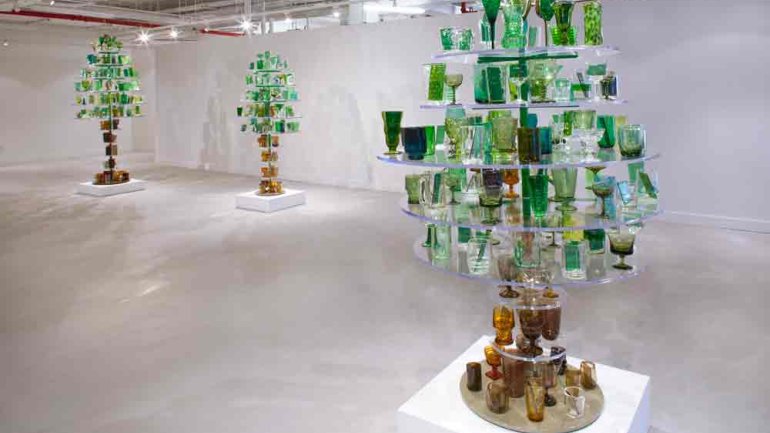Expanded UrbanGlass Facility Opens
UrbanGlass operates as a school, gallery, and studio space in Brooklyn for more than 200 glass artists. Today marks the reopening of the facility, which has been undergoing renovation for two years. The 17,000-square-foot space includes a hot shop, cold shop, kiln room, lamp shop, mold room, and flat working area. We asked Cybele Maylone, who became UrbanGlass’ executive director in May, about the organization and its new digs.
Tell us about Urban Glass' beginnings and how it has developed over the years.
UrbanGlass was founded in 1977 by artists Richard Yelle and Erik Erikson and came about because of a need for artists working with glass to have a place to create. It was the first open-access studio in the country, and a rich artistic community developed in the studio; artists began to travel from all around the New York City area as well as from around the world to use our facilities. Seeing a need for the critical consideration of work being created in glass, UrbanGlass expanded its mission to present exhibitions and publish a magazine, Glass: The UrbanGlass Art Quarterly, which launched in 1979.
What other services does the organization offer?
UrbanGlass has an artist-in-residence program, which brings emerging and established artists into our studios to create new bodies of work. These artists may be new to glass or interested in pushing their work in a new direction. Recent visiting artists have included sculptors and video artists, along with accomplished artists working in glass. In addition, our education program runs the Bead Project, a scholarship-based program for low-income women. Participants in the program learn how to make beads and run a small business, with the goal of developing supplemental income through jewelry sales. Both of these programs speak to UrbanGlass' mission to expand the use of glass as a creative medium.
Over the last couple of years, Urban Glass has been undergoing a huge renovation at its Brooklyn headquarters. What sparked the renovation, and what will the new facility offer to artists?
The renovation was initiated by New York City as part of an ongoing effort to enhance the Brooklyn cultural district, which we are lucky to be a part of. While UrbanGlass raised $2.5 million toward the project, the City invested $33 million in the improved and expanded facility. UrbanGlass now has one of the most advanced studios in the world, which gives artists and students the opportunity to work with the best equipment possible. In addition, our renovated facility features the Agnes Varis Art Center, which brings UrbanGlass' exhibition program and the work of artists working in glass to a much larger audience. This is the first time UrbanGlass has had a street-level presence, which we’re devoting to our gallery and store; that presence allows us to expand the dialogue about the medium in a significant way.
Where have Urban Glass artists been working during the renovation?
Throughout our renovation, UrbanGlass has maintained a temporary studio about a mile away, where artists have worked continuously. A lively community has been built in that studio, which features a comprehensive cold shop, flame shop, and flat shop. Artists seeking hot-shop access have taken advantage of the smaller studios in New York City and traveled to places around the state and country to work.
What has been the most surprising part of the renovation?
It has proven challenging to build a glass studio with a construction company and engineering team that has never done something like this before; it’s a really specific kind of space. But more than anything, I would say it’s been most surprising – and gratifying – to take artists and students who haven’t been here for two years through the new space. Many of them have been surprised and truly overwhelmed by the changes.
You are new to the glass world. What drew you to the job of executive director?
I am drawn to organizations that serve both artists and the public, and the position spoke to my interest in working with both of these constituencies. While I am new to glass, I have the great fortune of working with a staff, board, and artist community with a deep knowledge of the material who have been eager to help me learn. Glass is an incredible material, and it didn't take long to become seduced!
What is next for UrbanGlass?
The new UrbanGlass is presenting an ambitious schedule of programming that will highlight some of the most sophisticated work being done by artists working with glass. For the inaugural exhibition in our Agnes Varis Art Center, we are presenting a large-scale installation by the artist Katherine Gray, an artist from Los Angeles. For the show, Gray is using the form of the tree to reflect the communal nature of the glass community with an installation composed of drinking glasses from artists around the world. We are also activating our gallery and studios with performances by artists including the Burnt Asphalt Family, an artist collective that uses the hot shop to create food-based installations and environments.
Monica Moses is American Craft's editor in chief.

